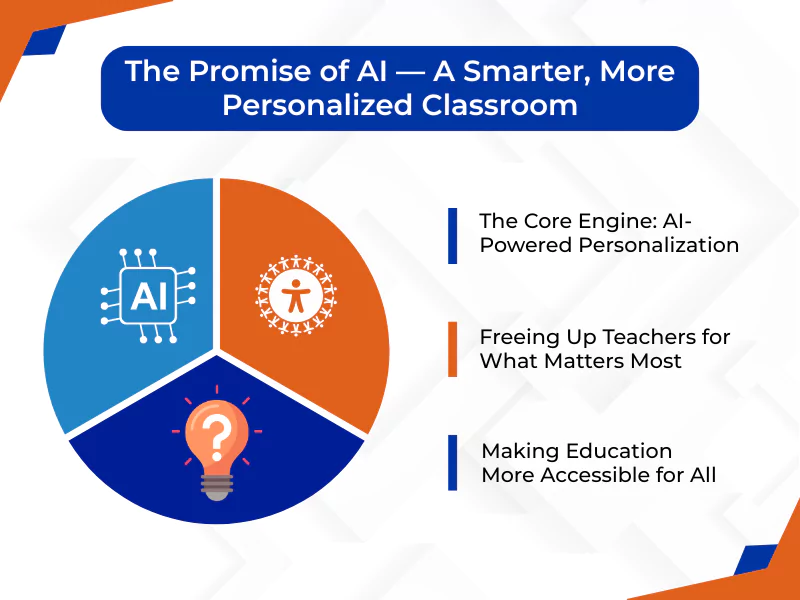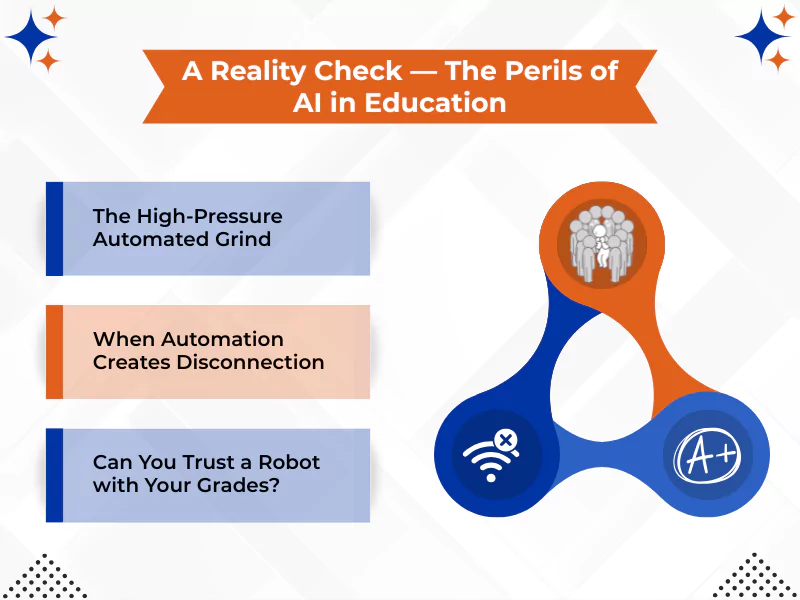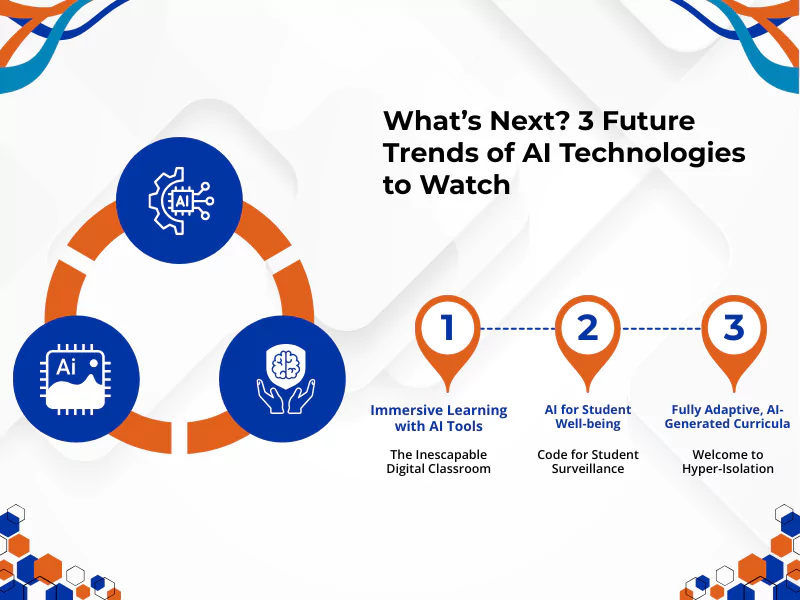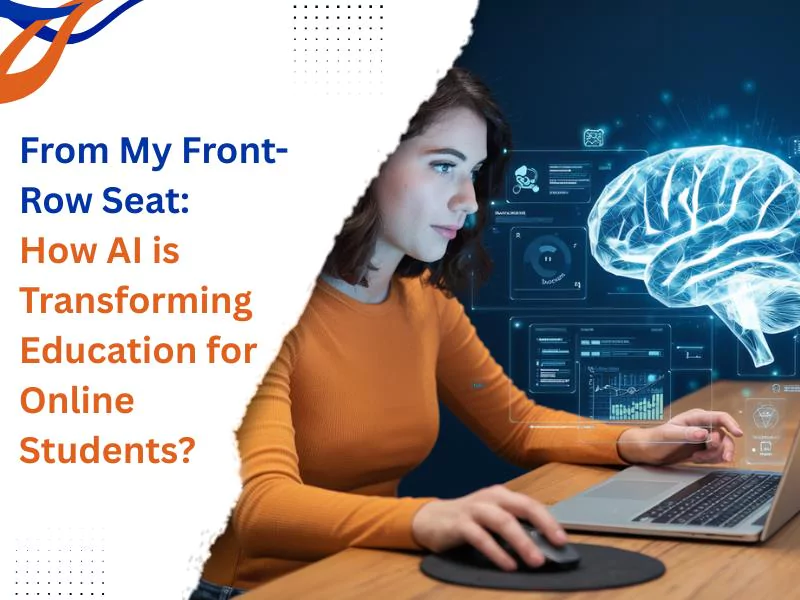Table of Contents
ToggleArtificial Intelligence is rapidly revolutionizing the educational landscape, sparking both excitement and significant concern. With 36% of college students using tools like ChatGPT to complete their schoolwork, many parents and teachers are questioning the future of academic integrity.
However, this concern only tells half the story. While students are adopting AI, so are the platforms on which they learn. AI is being integrated into the Learning Management Systems (LMS) used by over 73 million people in the US, promising to create personalized learning paths that can boost knowledge retention by up to 60%.
So, is AI a threat or an ally? Let’s discover how AI is reshaping the future of online classes—from its incredible promises to its challenging realities.
The Promise of AI — A Smarter, More Personalized Classroom

At its best, AI acts as a powerful tool for augmenting human capabilities, a sentiment echoed by Google CEO Sundar Pichai. AI in education technology: This promise manifests in three key areas.
1. The Core Engine: AI-Powered Personalization
Imagine a tutor who knows exactly what you’re good at, where you struggle, and how you learn best. This is the goal of AI-powered personalization. Instead of a one-size-fits-all lesson, AI-powered platforms like ALEKS and Pearson MyLab can analyze a student’s progress in real-time. This is called adaptive learning, which is making learning more personalized by empowering intelligent tutoring systems.
For instance, if a student struggles with adding fractions with unlike denominators, the artificial intelligence in online education can diagnose the specific root issue—perhaps a weakness in finding the lowest common multiple. It can then automatically serve a targeted 3-minute video and follow-up exercises on that exact concept. Conversely, if a student masters a topic, the AI enhances and tailors more advanced challenges to prevent boredom and keep them engaged, shaping the future of lifelong learning with natural language processing.
2. Freeing Up Teachers for What Matters Most
Teachers are often buried under administrative work, from automated grading papers to tracking attendance. AI tools for academic success can automate many of these routine tasks, freeing up valuable time for teachers to focus on what they do best: mentoring students, facilitating discussions, and providing one-on-one teaching and learning support. As US educator Matt Miller notes, if AI cuts planning or grading time in half,
“In the end, if using AI tools cuts your planning time from 30 minutes to 18 minutes—or your grading time from 40 minutes to 22—that extra time it creates is yours. Use it however you wish. Plan out that cool lesson you’ve always wanted to do. Or go home early. The choice is yours. I know this type of decision feels pretty foreign to us—deciding what to do with extra time. Whether we use it to do something amazing for our students or preserve our mental health, everyone wins.”
3. Making Education More Accessible for All
AI has the power to make the learning experience more inclusive. For students with disabilities, AI can provide text-to-speech solutions (like JAWS screen readers) or generate real-time captions and sign language for the hearing-impaired. For non-native speakers, tools integrated into Microsoft Teams or Zoom can translate learning materials, breaking down language barriers and improving comprehension. This helps bridge the gap between different communities, making quality education accessible to anyone with an internet connection.
A Reality Check — The Perils of AI in Education

While the promises and benefits of AI in online classes are compelling, the current reality of AI in online classes often falls short, creating new pressures and ethical dilemmas.
1. The High-Pressure Automated Grind
The personalized tutor of AI technologies can quickly feel like a nagging robot. If a student finds a concept difficult, the AI can bury them in endless, repetitive drills that feel more like a punishment than help. This relentless push to perform flawlessly can lead to burnout and transform learning into a high-pressure, automated grind where the student is constantly being measured. The “instant feedback” from tools like Grammarly can cover an essay in a “sea of red highlights,” creating anxiety by nitpicking details instead of engaging with the student’s ideas.
2. When Automation Creates Disconnection
When teachers outsource grading and feedback to AI, they risk becoming disconnected from their students’ actual struggles. Instead of receiving one-on-one help from a person who understands their needs, students are often told to simply “trust the system,” leaving them to fight an automated platform alone. Therefore, while AI is changing and transforming education, it is taking away the fun because no virtual experiment can replace hands-on learning!
3. Can You Trust a Robot with Your Grades?
This brings us to a critical ethical dilemma. As OpenAI’s CEO Sam Altman has noted,
“In some sense AIs are like a top competitive programmer in the world now or AIs can get a top score on the world’s hardest math competitions or AIs can do problems that I’d expect an expert PhD in my field to do,” he told the Uncapped podcast (hosted by Sam’s brother, Jack Altman).
However, this incredible power is paired with a critical weakness. As he also pointed out,
“People have a very high degree of trust in ChatGPT, which is interesting, because AI hallucinates. It should be the tech that you don’t trust that much.”
For a student, being forced to use a tool that could be wrong is a major risk. The future of digital education with AI raises serious questions:
The Unfair Robot Grader: An AI trained on a narrow dataset (like old history books) may unfairly penalize a student for using modern language or a creative style it doesn’t recognize. The unfairness is built directly into the program.
Are You a Student or a Science Experiment? AI platforms track every click, every pause, and every re-watched video to build a digital profile on you. Who sees this data? Is it being used to help you, or to help companies make money? This lack of transparency turns students into test subjects in a massive educational experiment.
What’s Next? 3 Future Trends of AI Technologies to Watch

The same tech companies pushing today’s flawed systems are already planning their next move. Here are three trends that promise to make online education even more immersive and data-driven.
Immersive Learning with AI Tools: The Inescapable Digital Classroom
1. The Promise: Imagine learning history not from a book, but by walking through ancient Rome in virtual reality (VR). This promises a hands-on, engaging experience.
2. The Reality: This means education becomes inescapable. It’s no longer flexible learning; it’s a total-immersion demand on your time and energy, adding a new layer of technical and mental burden.
AI for Student Well-being: Code for Student Surveillance
1. The Promise: Universities will introduce AI that “monitors your well-being” to flag signs of burnout or stress.
2. The Reality: This is AI for Student Surveillance. The technology will analyze your sentiment in forums and track your activity to create a psychological profile without your consent, adding a creepy and invasive layer to your education.
Fully Adaptive, AI-Generated Curricula: Welcome to Hyper-Isolation
1. The Promise: An AI will create an entire, one-of-a-kind “bespoke” course just for you.
2. The Reality: This is Hyper-Isolation. If your course is completely unique, you can no longer turn to classmates for help. Study groups become useless. You are left completely alone, trapped in a digital bubble with only a flawed algorithm to guide you.
From My Front-Row Seat: How AI is Transforming Education for Online Students?

As an academic helper, I’ve seen firsthand how AI is transforming online classes from static syllabi into personal tutors. The most advanced Learning Management Systems (LMSs) no longer just present information; they analyze how a student learns—where they hesitate, what they re-watch—to diagnose the why behind a mistake.
They track things like:
- Which concepts do they review multiple times?
- How long does a student hesitate on a specific quiz question?
- Whether they learn better from watching a video or engaging with an interactive model?
From my perspective, this is where the magic happens. Instead of just flagging a wrong answer, the AI diagnoses the why.
In one instance, I saw an AI system (Pearson MyMathLab) flag that a student wasn’t just struggling with fractions, but specifically with adding fractions with unlike denominators. It then served a 3-minute video on finding the lowest common multiple, a level of diagnostic precision that would be difficult for a teacher managing 30 students to achieve in real-time. Resultantly, the student needed online class help.
Instead of just marking answers wrong, the AI detected the root issue and automatically offered a foundational video. While the AI’s diagnosis was correct, its solution was just another video. The student still needed hands-on, expert help to understand and complete the work truly.
The Takeaway: Humans + AI is the Future of Learning
AI is reshaping education, and it is here to stay. The key is not to reject it, but to learn how to use it for a better outcome. The debate over AI is not just about technology; it’s about our values.
The future is not about AI replacing teachers, but about redefining their roles. As AI handles routine tasks, teachers can evolve from “lecturers” to “learning facilitators” who mentor, inspire critical thinking, and provide the uniquely human support that no algorithm can replicate.
As one popular saying goes, AI may not replace you, but a person using AI will. Learning to navigate this new world, with both its opportunities and its challenges, is the first step toward unlocking a more effective and equitable future for education.
Frequently Asked Questions
Will AI Replace Teachers in the Future of Education?
No, AI is not positioned to replace teachers. AI is a transformational force, and its role is to empower teachers by handling repetitive tasks like grading and data analysis. This frees up teachers to focus on the uniquely human aspects of education: mentoring, providing emotional support, and inspiring curiosity. The teacher’s role will shift from a “lecturer” to an expert “facilitator.”
How Can Students Use AI Ethically Without Cheating?
The key is to use AI as a tool for learning, not as a machine for producing final answers. Ethical use involves:
- Brainstorming and Idea Generation: Using AI to explore topics or outline an essay before you start writing.
- Concept Clarification: Asking an AI chatbot to explain a difficult concept in a different way.
- Personalized Tutoring: Using AI for practice quizzes to identify areas where you need more study.
- Checking and Refining Your Work: Using AI (like Grammarly) to check for grammatical errors or suggest ways to rephrase a sentence for clarity after you have written a draft.
What Does "Personalized Learning" with AI Actually Look Like in a Real Class?
Imagine two students in the same math class. One struggles with fractions, while the other excels. With AI, their experiences differ:
- The struggling student’s learning platform (like ALEKS) detects their incorrect answers. It automatically provides them with a foundational video on the topic, followed by targeted practice exercises to help them catch up by giving personalized lessons.
- The advanced student answers the questions. The AI recognizes their mastery and offers a more complex challenge, like applying fractions to a real-world problem, keeping them engaged.
In essence, personalized learning means the curriculum adapts to each student’s pace and needs in real-time.

